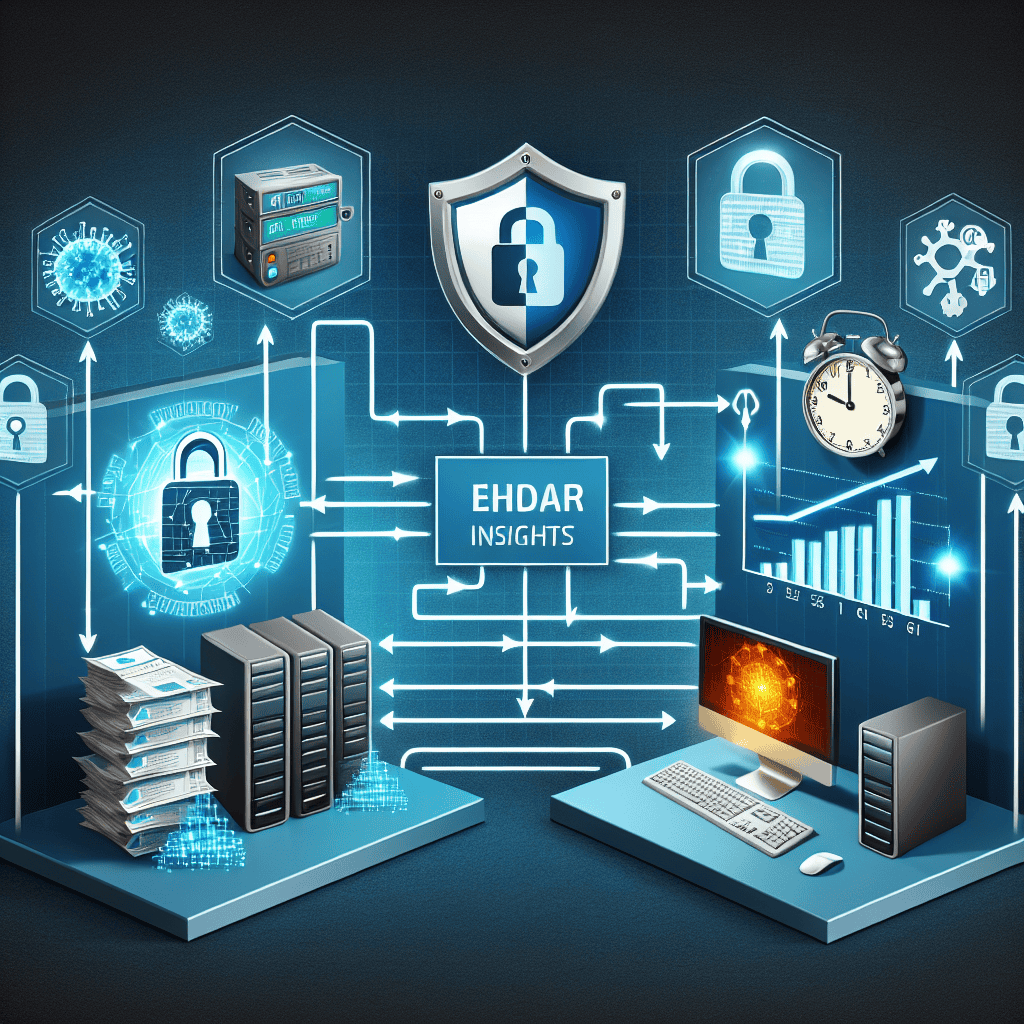Vendor Insights: Enhancing Cybersecurity and EHR Performance Upgrades

In the rapidly evolving landscape of healthcare technology, Electronic Health Records (EHR) systems have become indispensable. They streamline patient data management, improve care coordination, and enhance patient outcomes. However, with the increasing reliance on digital systems, the need for robust cybersecurity measures and performance upgrades has never been more critical. This article delves into the intricacies of enhancing cybersecurity and EHR performance, providing valuable insights for healthcare providers and IT professionals.
Understanding the Current EHR Landscape
The adoption of EHR systems has transformed healthcare delivery, offering numerous benefits such as improved patient care, increased efficiency, and reduced costs. However, the integration of these systems also presents significant challenges, particularly in terms of cybersecurity and performance optimization.
The Rise of EHR Systems
Over the past decade, the healthcare industry has witnessed a significant shift towards digitalization, with EHR systems at the forefront. According to the Office of the National Coordinator for Health Information Technology, nearly 86% of office-based physicians had adopted EHR systems by 2017. This widespread adoption is driven by the need for efficient data management and improved patient care.
Despite their benefits, EHR systems are not without challenges. Healthcare providers often face issues related to data security, system interoperability, and user satisfaction. These challenges necessitate continuous performance upgrades and robust cybersecurity measures to ensure the integrity and confidentiality of patient data.
Challenges in EHR Implementation
Implementing EHR systems is a complex process that involves significant financial investment, time, and resources. One of the primary challenges is ensuring system interoperability, which is crucial for seamless data exchange between different healthcare providers. Lack of interoperability can lead to fragmented patient data, resulting in suboptimal care and increased healthcare costs.
Another challenge is user satisfaction. Many healthcare professionals find EHR systems cumbersome and time-consuming, leading to decreased productivity and increased burnout. Addressing these issues requires continuous system upgrades and user training to enhance usability and efficiency.
The Importance of Cybersecurity in EHR Systems
As EHR systems store vast amounts of sensitive patient data, they are prime targets for cyberattacks. Data breaches can have severe consequences, including financial losses, reputational damage, and compromised patient care. According to a report by IBM Security, the average cost of a data breach in the healthcare sector was $7.13 million in 2020, the highest among all industries.
To mitigate these risks, healthcare providers must implement robust cybersecurity measures, including encryption, access controls, and regular security audits. Additionally, staff training on cybersecurity best practices is essential to prevent human errors that could lead to data breaches.
Case Study: Successful EHR Implementation
One notable example of successful EHR implementation is the Mayo Clinic, which has integrated a comprehensive EHR system across its facilities. The system allows for seamless data exchange between different departments, improving care coordination and patient outcomes. The Mayo Clinic’s success can be attributed to its focus on interoperability, user training, and continuous system upgrades.
By prioritizing these aspects, the Mayo Clinic has managed to overcome common EHR challenges, setting a benchmark for other healthcare providers. Their experience highlights the importance of strategic planning and investment in technology to achieve successful EHR implementation.
Future Trends in EHR Systems
Looking ahead, the future of EHR systems is likely to be shaped by advancements in artificial intelligence (AI) and machine learning. These technologies have the potential to enhance data analysis, improve diagnostic accuracy, and personalize patient care. Additionally, blockchain technology could revolutionize data security by providing a decentralized and tamper-proof system for storing patient records.
As these technologies continue to evolve, healthcare providers must stay abreast of the latest trends and innovations to ensure their EHR systems remain secure and efficient. This requires ongoing investment in technology and a commitment to continuous improvement.
Enhancing Cybersecurity in EHR Systems
Cybersecurity is a critical component of EHR systems, as they store and process vast amounts of sensitive patient data. Ensuring the security and integrity of this data is paramount to maintaining patient trust and complying with regulatory requirements.
Common Cybersecurity Threats
Healthcare organizations face a myriad of cybersecurity threats, ranging from ransomware attacks to insider threats. Ransomware attacks involve malicious software that encrypts data, rendering it inaccessible until a ransom is paid. These attacks can disrupt healthcare operations and compromise patient care.
Insider threats, on the other hand, involve employees or contractors who misuse their access to sensitive data for malicious purposes. These threats can be challenging to detect and prevent, as they often involve individuals with legitimate access to the system.
Implementing Robust Security Measures
To protect against these threats, healthcare providers must implement a multi-layered approach to cybersecurity. This includes:
- Encryption: Encrypting data both at rest and in transit ensures that even if data is intercepted, it cannot be read without the appropriate decryption key.
- Access Controls: Implementing strict access controls ensures that only authorized personnel have access to sensitive data. This includes using multi-factor authentication and role-based access controls.
- Regular Security Audits: Conducting regular security audits helps identify vulnerabilities and ensure compliance with regulatory requirements.
- Incident Response Plan: Having a well-defined incident response plan ensures that healthcare providers can quickly and effectively respond to security incidents, minimizing their impact.
Staff Training and Awareness
Human error is a significant factor in many data breaches, making staff training and awareness crucial components of a robust cybersecurity strategy. Healthcare providers should conduct regular training sessions to educate staff on cybersecurity best practices, such as recognizing phishing emails and using strong passwords.
Additionally, fostering a culture of security awareness encourages employees to take an active role in protecting patient data. This includes reporting suspicious activities and adhering to security protocols.
Case Study: Cybersecurity Breach in Healthcare
In 2017, the WannaCry ransomware attack affected numerous organizations worldwide, including the UK’s National Health Service (NHS). The attack disrupted healthcare services, leading to canceled appointments and delayed treatments. The incident highlighted the importance of robust cybersecurity measures and the need for healthcare providers to be prepared for such attacks.
In response to the attack, the NHS implemented several security measures, including patching vulnerabilities, enhancing network security, and conducting staff training. These efforts have helped improve the NHS’s cybersecurity posture and prevent future incidents.
The Role of Regulatory Compliance
Regulatory compliance plays a crucial role in ensuring the security of EHR systems. In the United States, the Health Insurance Portability and Accountability Act (HIPAA) sets standards for protecting patient data. Healthcare providers must comply with HIPAA requirements, including implementing security measures and conducting regular risk assessments.
Failure to comply with regulatory requirements can result in significant penalties and reputational damage. Therefore, healthcare providers must prioritize compliance as part of their cybersecurity strategy.
Optimizing EHR Performance
While cybersecurity is a critical aspect of EHR systems, optimizing their performance is equally important. Efficient EHR systems enhance user satisfaction, improve patient care, and reduce operational costs.
Identifying Performance Bottlenecks
Performance bottlenecks can significantly impact the efficiency of EHR systems, leading to slow response times and decreased productivity. Common bottlenecks include:
- Hardware Limitations: Outdated hardware can limit the performance of EHR systems, resulting in slow processing speeds and increased downtime.
- Software Inefficiencies: Inefficient software design or coding can lead to performance issues, such as slow loading times and system crashes.
- Network Congestion: High network traffic can cause delays in data transmission, affecting the overall performance of EHR systems.
Identifying and addressing these bottlenecks is crucial for optimizing EHR performance and ensuring seamless healthcare delivery.
Implementing Performance Enhancements
To enhance the performance of EHR systems, healthcare providers can implement several strategies, including:
- Upgrading Hardware: Investing in modern hardware, such as high-performance servers and storage solutions, can significantly improve system performance.
- Optimizing Software: Regularly updating software and optimizing code can enhance system efficiency and reduce the risk of crashes.
- Improving Network Infrastructure: Upgrading network infrastructure, such as routers and switches, can reduce congestion and improve data transmission speeds.
- Implementing Load Balancing: Distributing workloads across multiple servers can prevent overloading and ensure consistent performance.
User Training and Support
User training and support are essential components of optimizing EHR performance. Healthcare providers should conduct regular training sessions to familiarize staff with system features and functionalities. This helps improve user satisfaction and reduces the likelihood of errors.
Additionally, providing ongoing technical support ensures that users can quickly resolve any issues they encounter, minimizing disruptions to healthcare delivery.
Case Study: EHR Performance Optimization
The Cleveland Clinic is a prime example of successful EHR performance optimization. By investing in modern hardware and software solutions, the clinic has significantly improved system efficiency and user satisfaction. Additionally, the clinic has implemented a comprehensive training program to ensure staff are proficient in using the EHR system.
These efforts have resulted in improved patient care and reduced operational costs, demonstrating the importance of performance optimization in healthcare settings.
The Future of EHR Performance Optimization
As technology continues to evolve, the future of EHR performance optimization is likely to be shaped by advancements in cloud computing and AI. Cloud-based EHR systems offer scalability and flexibility, allowing healthcare providers to easily adapt to changing needs. Additionally, AI-powered analytics can provide valuable insights into system performance, enabling proactive optimization efforts.
By embracing these technologies, healthcare providers can ensure their EHR systems remain efficient and effective, ultimately improving patient care and outcomes.
Vendor Collaboration for EHR Enhancements
Collaboration with vendors is a crucial aspect of enhancing EHR systems. Vendors play a vital role in providing the necessary tools, technologies, and support to optimize system performance and ensure robust cybersecurity.
Selecting the Right Vendor
Choosing the right vendor is a critical decision that can significantly impact the success of EHR implementation and optimization efforts. Healthcare providers should consider several factors when selecting a vendor, including:
- Experience and Expertise: Vendors with a proven track record in the healthcare industry are more likely to deliver successful outcomes.
- Product Features: The vendor’s product should offer the necessary features and functionalities to meet the healthcare provider’s specific needs.
- Support and Training: Vendors should provide comprehensive support and training to ensure successful implementation and ongoing optimization.
- Cost and Value: The vendor’s pricing should align with the healthcare provider’s budget while offering good value for money.
Building Strong Vendor Relationships
Building strong relationships with vendors is essential for successful EHR enhancements. Healthcare providers should establish open lines of communication and collaborate closely with vendors to address any challenges or issues that arise.
Regular meetings and feedback sessions can help ensure that both parties are aligned on goals and objectives, facilitating successful collaboration and continuous improvement.
Case Study: Successful Vendor Collaboration
The University of Pittsburgh Medical Center (UPMC) is an example of successful vendor collaboration. By partnering with a leading EHR vendor, UPMC has implemented a state-of-the-art EHR system that enhances patient care and operational efficiency. The collaboration has involved regular communication, joint problem-solving, and ongoing support, resulting in a successful partnership that benefits both parties.
This case study highlights the importance of strong vendor relationships in achieving successful EHR enhancements and optimizing healthcare delivery.
The Role of Vendor Support in Cybersecurity
Vendors play a crucial role in ensuring the cybersecurity of EHR systems. They provide the necessary tools and technologies to protect against cyber threats, such as encryption solutions and access controls. Additionally, vendors offer ongoing support and updates to address emerging threats and vulnerabilities.
Healthcare providers should work closely with vendors to ensure their EHR systems remain secure and compliant with regulatory requirements. This includes conducting regular security assessments and implementing recommended security measures.
Future Trends in Vendor Collaboration
As the healthcare industry continues to evolve, vendor collaboration is likely to become increasingly important. Emerging technologies, such as AI and blockchain, will require healthcare providers to work closely with vendors to implement and optimize these solutions.
By fostering strong vendor relationships and staying abreast of the latest trends and innovations, healthcare providers can ensure their EHR systems remain secure, efficient, and effective.
Conclusion: Key Takeaways
Enhancing cybersecurity and EHR performance is a complex but essential task for healthcare providers. By understanding the current EHR landscape, implementing robust security measures, optimizing system performance, and collaborating with vendors, healthcare providers can ensure their EHR systems remain secure and efficient.
The key takeaways from this article include:
- The importance of robust cybersecurity measures to protect sensitive patient data and maintain regulatory compliance.
- The need for continuous performance optimization to enhance user satisfaction and improve patient care.
- The role of vendor collaboration in providing the necessary tools, technologies, and support for successful EHR enhancements.
- The significance of staff training and awareness in preventing data breaches and optimizing system performance.
- The potential of emerging technologies, such as AI and blockchain, to revolutionize EHR systems and improve healthcare delivery.
By prioritizing these aspects, healthcare providers can enhance their EHR systems, ultimately improving patient outcomes and operational efficiency.





